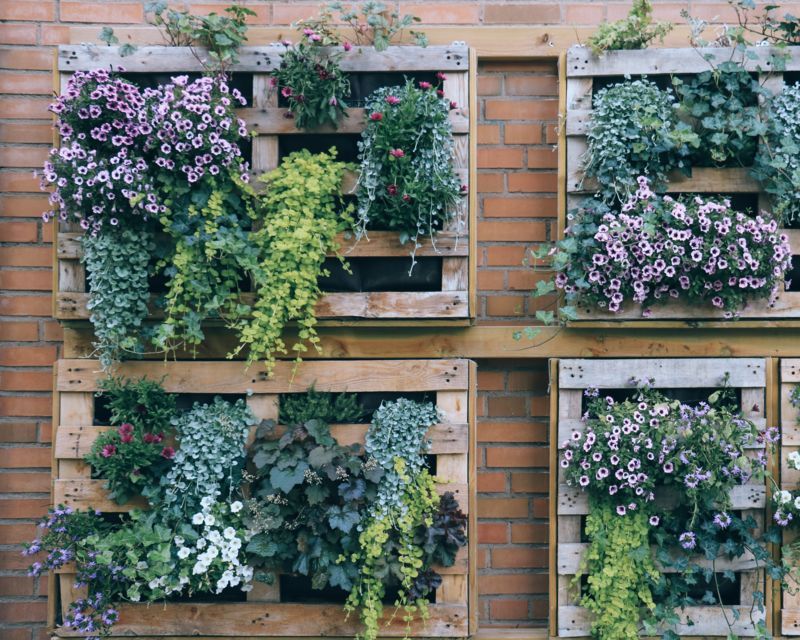Yates Account
Join now
Create a Yates account today!
Sign up to join the Yates Garden Club for monthly e-mails packed with seasonal inspiration, tips for success & exclusive promotions.
Plus if you’re a Garden Club member you can take part in the Yates Growing Community - a blog to share successes, get advice & win prizes in fun challenges along the way!

Forgot password
Enter the email address associated with your account, and we'll email you a new password.

The most fashionable trend in the gardening world at the moment just has to be vertical gardens. Also called living walls or green walls, vertical gardens are used to save space but mostly to create dramatic effect. Here are some tips on how to create your very own vertical garden.
Check to see how much sun the wall or fence receives throughout the various seasons. In some cases, walls will bake in the summer sun and then be in total shade through winter. There are very few plants that can cope with such extremes. A surface that is in full sun all year will get very hot and will require constant maintenance. Gentle, filtered shade or morning sun/ afternoon shade are probably the best aspects to choose to enable the widest plant choice.
The easiest way to create your green wall is to buy one of the numerous kits that have been expressly produced for this purpose but you can also set up your own system. The choice of containers is endless – only limited by your imagination. Anything that will hold mix for the plant to grow in can be used.
The growing medium is important, especially if you want your display to last for a long time. It must be capable of holding nutrients and moisture, but must not be too heavy. Don’t use garden soil as it will set like cement between waterings. Good quality potting mix can be mixed 50:50 with lightweight perlite, vermiculite or small styrofoam balls.

Success depends on effective irrigation. Most pre-formed vertical systems have some arrangement for watering but, if you’re setting up your own system, give some thought to watering and drainage. Hand watering will be satisfactory for a small wall but be sure to check the plants and pots regularly to ensure they don’t dry out. Those at the top of the wall or in the more open positions will need more watering than sheltered plants.
Plant choice is critical to success with vertical gardens. To start with, don’t attempt to grow anything too large. Small succulents make good choices for sunnier spots. Bromeliads do well in semi-shade and, because so many of them are epiphytes (plants that naturally grow in trees) they don’t need much root room. Their roots can be bedded into something like sphagnum moss, which is much lighter than potting mix. Strappy leafed plants with a slightly drooping habit will perform well. Examples are small dianellas, mondo grass, Lomandra ‘Little Con’, liriope and, possibly best of all, walking iris (Neomarica sp.). The latter has glossy green leaves, pretty spring flowers and small, easily detached plantlets that form at the end of long shoots. Seasonal herbs and flowering annuals can be mixed in to add short term interest or colour.
Getting started – choosing a frame
If DIY isn’t your thing, you can buy ready-made vertical garden kits, frames and pots from your local hardware store or garden centre.
They come in different sizes and shapes to suit your available space and design style. For the more creative, you can make your own frame using recycled wooden pallets.
Successful vertical gardens depend on effective watering, as they can dry out very quickly. Many pre-made vertical gardens have in-built irrigation systems, otherwise DIY garden walls will need to be regularly hand watered or irrigation included in your design.
What to plant
Edible wall: Make your vertical garden edible by planting herbs and vegetables! Not only will your vertical garden fill your salad bowls and season your soups, it will smell divine! Try the following at your place:
- Parsley
- Coriander
- Chilli
- Lettuce
- Bok choy
- Rosemary
- Basil.
Care tips:
- It’s important to not use garden soil in vertical gardens, which can be poorly drained. Instead, use a good quality potting mix, such as Yates Premium Potting Mix.
- To promote healthy growth, feed vertical gardens regularly with Yates Thrive Natural Fish & Seaweed+ Plant Food Concentrate.
- Match your vertical garden with plants to suit the amount of sunshine it will receive in various seasons. Gentle morning sun with afternoon shade will suit the widest variety of plants.
Other vertical gardens to try:
Tropical wall: For a lush, tropical vibe I recommend planting swiss cheese plant, sword fern and devil’s ivy. These plants will give a holiday vibe to any balcony or patio!
Succulent wall: For a lower maintenance vertical garden, choose drought-resistant succulents such as golden and blue feather sedums and sempervivum (‘hens and chicks’).
Flower wall: For a colourful wall, choose petunias, begonias, orchids and mix in with some soft green baby’s tears.














Share
Share this article on social media